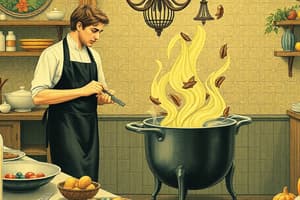Podcast
Questions and Answers
What is the primary purpose of proofing dough?
What is the primary purpose of proofing dough?
- To allow the dough to rise (correct)
- To maintain moisture in the dough
- To enhance flavor through fermentation
- To develop gluten structure
What is cross-contamination?
What is cross-contamination?
- Cooking food at incorrect temperatures
- Mixing raw and cooked foods
- Bacteria transferring from one food substance to another (correct)
- Spoilage due to improper storage
What is the minimum internal temperature required for poultry to be considered safe to eat?
What is the minimum internal temperature required for poultry to be considered safe to eat?
- 155°F
- 145°F
- 165°F (correct)
- 175°F
Which utensil is commonly used to make flaky dough?
Which utensil is commonly used to make flaky dough?
Why is it important to soak wooden skewers in water before cooking?
Why is it important to soak wooden skewers in water before cooking?
What does the term 'FIFO' stand for in food safety?
What does the term 'FIFO' stand for in food safety?
Which method is used to keep cooked broccoli visually appealing after cooking?
Which method is used to keep cooked broccoli visually appealing after cooking?
What is the role of an icing knife in cake decoration?
What is the role of an icing knife in cake decoration?
Flashcards
Sear
Sear
A method of cooking food, often meat, where the item is placed on high heat to create a caramelized crust. This technique helps lock in moisture and flavor.
Pasteurization
Pasteurization
The process of heating liquids to a high temperature, killing bacteria, and then cooling them down quickly. This preserves freshness and safety.
Egg Wash
Egg Wash
An edible paste made from flour, water, and sometimes other ingredients, used to coat food, typically breads and pastries, and create a shiny, golden-brown crust.
Braising
Braising
Signup and view all the flashcards
Minimum Internal Temperature
Minimum Internal Temperature
Signup and view all the flashcards
Blanching
Blanching
Signup and view all the flashcards
Proofing
Proofing
Signup and view all the flashcards
Cutting on a Bias
Cutting on a Bias
Signup and view all the flashcards
Study Notes
Food Preparation Techniques
- Butterfly meat: To create even cooking and more surface area for flavour.
- Flowering a pan: (Method not described, details needed).
- Cross-contamination: The transfer of bacteria from one food to another. Important to prevent this in food safety.
- Food safety: Time and temperature control are critical for safety.
- Preparation: Organize ingredients, measure accurately and prepare in advance.
- Wooden skewers: Soak in water to prevent burning.
- Proofing: A process of allowing dough to rise.
- Pretzels: Dough not allowed to proof.
- Rating systems: CAA Diamonds, Forbes Travel Guide, and Michelin Stars are used to rate quality.
- Leveling a cake: Tools such as cake wire, dental floss, and or a bread knife are used.
Food and Cooking
- Mini chocolate chips in cookies: Improves chocolate distribution.
- Chicken cooking methods: Oven and charred grill.
- Expensive items: Presidential suite, real estate in Montreal.
- Cinnamon rolls: Made in stages (two steps).
- Cookie dough: Does not have yeast and isn't truly dough.
- Pastry cutter: Tool with rounded rings that cuts fat into flour.
- Salad dressing: Store-bought dressings often have high sodium and no preservatives.
- Travel agents: Provide itineraries and costs of trips.
- Tourism sectors: 8 sectors for tourism: Accommodations, food, attractions, transportation, adventure, events, travel trade, and tourism services.
- Eggs in burgers: Helps bind the ingredients.
- Boning knife: Used to separate meat from bone.
- Standard egg size: Large eggs are commonly used.
- Recipe information: Yield, time, measurements, ingredients, steps.
- Carrot cuts: Diagonal cuts are called "on the bias."
- Blanching broccoli: Place in ice water after cooking to retain colour and texture.
- Mother sauces: Tomato and béchamel are the two mother sauces.
- FIFO: First-In, First-Out inventory management.
- Minimum internal temperature: Safety temperature for food consumption.
- Adding air: Whisk attachment adds air.
- HACCP: Hazard Analysis and Critical Control Points system.
- Pasteurization: Heating food very high to kill germs.
- Scalding milk: Heating milk until it bubbles just starting.
- Flakey dough: Pastry cutter creates a flakey dough texture.
- Cleaning: Clean as you go and at the end of preparation.
- Holding food: Keeping warm temperature by using appropriate holding equipment
- Safe point: Danger zone is 40°F to 165°F; safety point is 165
- Drying food: Dried products become stronger.
- Icing a cake: Icing knife used.
- Braising: A long, slow cooking process.
- Carryover cooking: Continuing to cook even after the oven is turned off.
- Icing types: Buttercream and cream cheese icing types.
- Poultry minimum internal temperature: 165°F.
- Pretzel browning: Egg wash is used.
- Marinating: Adds flavour and tenderness.
- Sealing/Sear: Cooking on high heat to create a brown surface.
Studying That Suits You
Use AI to generate personalized quizzes and flashcards to suit your learning preferences.
Description
Explore essential food preparation techniques, such as butterfly meat and cross-contamination prevention. This quiz covers important aspects of food safety, proper cooking methods, and ingredient organization. Test your knowledge on the best practices in food handling and cooking processes.




